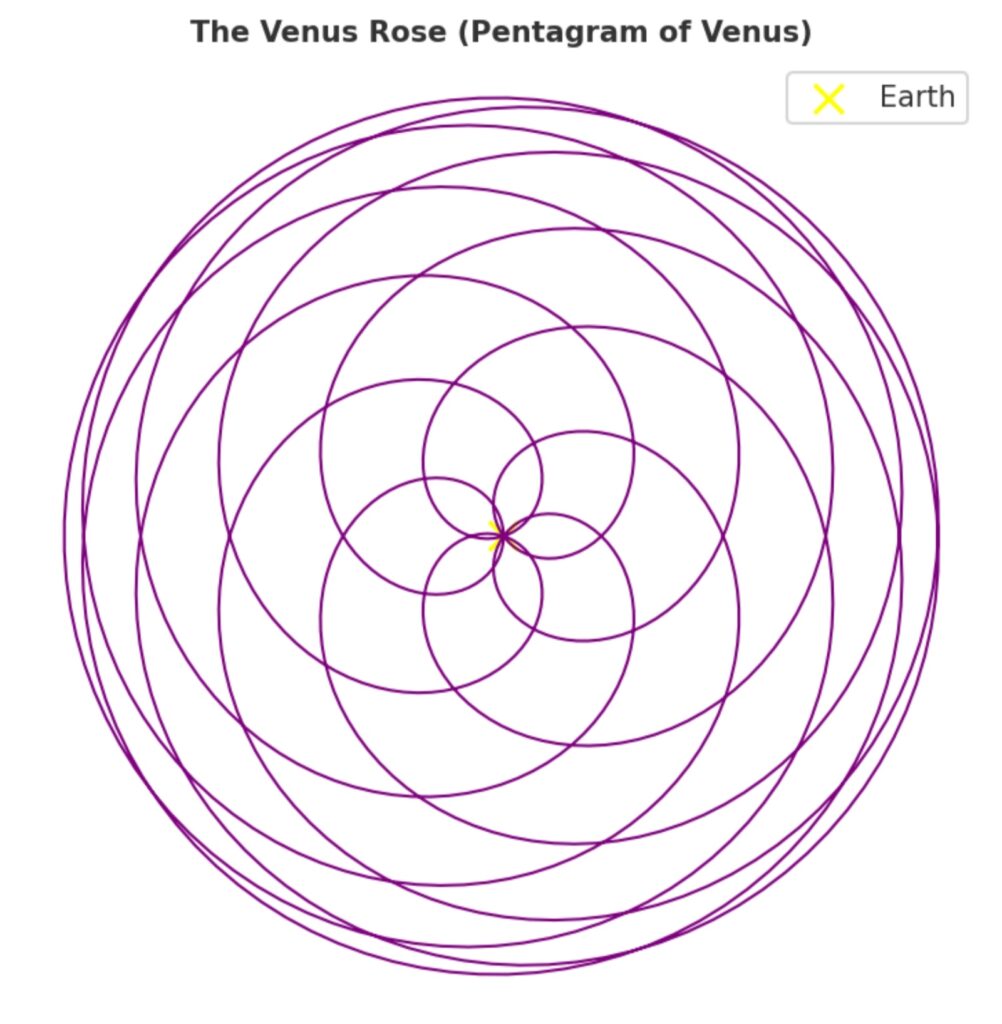Throughout history, humanity has marveled at the night sky, observing the movements of celestial bodies and seeking patterns in their motions. From ancient civilizations tracking planetary movements to modern astronomers mapping celestial mechanics, the cosmos has always inspired curiosity and wonder. Among the most mesmerizing and mathematically elegant patterns is the “Venus Rose” or the “Pentagram of Venus”—a stunning, flower-like orbital design that emerges from the unique relationship between Earth and Venus.
This celestial pattern is not just a beautiful geometric coincidence; it is the result of precise orbital mechanics that dictate how Venus and Earth interact over time. Every eight years, Venus traces a symmetrical, five-petaled design in the sky when viewed from Earth, creating a shape that has intrigued astronomers for centuries. This astronomical wonder is not only a testament to the harmony of planetary motion but also a bridge between science, art, and mysticism.
The Venus Rose has been recognized throughout history, appearing in ancient cultures, religious symbolism, and even esoteric traditions. Its near-perfect symmetry and connection to mathematical ratios have made it a subject of both scientific study and mystical interpretation. Whether viewed as a product of gravitational forces or a symbol of cosmic order, the Venus Rose stands as one of the most visually captivating patterns in our solar system.
By exploring the mechanics behind this phenomenon, we gain insight into the intricate dance of the planets and the hidden geometry of the universe. This article delves into the science behind the Venus Rose, its historical significance, and its broader cultural impact, revealing why this celestial pattern continues to fascinate observers across generations.
The Orbital Relationship Between Earth and Venus
At first glance, the paths of planets around the Sun may seem straightforward, but when observed from Earth, Venus traces an extraordinary pattern over time. The reason lies in the simple yet remarkable ratio between their orbits.
- Venus completes 13 orbits around the Sun in almost exactly the same time that Earth completes 8 orbits.
- This 13:8 orbital ratio means that every 8 years, Venus returns to nearly the same position relative to Earth and the Sun.
- When this motion is plotted from a geocentric (Earth-centered) perspective, Venus appears to draw a five-petaled flower, forming what is commonly known as the Venus Rose.
Each petal of this cosmic flower takes about 1.6 years to complete. Over 8 Earth years, Venus cycles through the same positions in the sky, recreating this intricate design before the cycle begins again.
Why Does Venus Trace a Rose-Shaped Path?
The answer lies in orbital mechanics. While Earth and Venus both orbit the Sun, their different speeds and distances from the Sun create a dynamic interplay.
- Earth orbits the Sun once per year, moving at a steady pace.
- Venus, being closer to the Sun, moves faster, completing one orbit in about 225 days.
- When observed from Earth, Venus appears to oscillate back and forth in the sky, creating loops that align perfectly every 8 years.
This results in a fivefold symmetry, which is an uncommon yet beautiful consequence of the mathematical ratios governing planetary motion.
A Pattern Recognized Through History
Ancient Civilizations and the Venus Cycle
- The Babylonians carefully tracked Venus’ movement, associating it with their goddess Ishtar.
- The Mayans had an advanced understanding of Venus’ cycle, integrating it into their calendar system and associating it with the god Kukulkan.
- The Greeks and Romans linked Venus to their goddess of love and beauty (Aphrodite/Venus), possibly due to its graceful, predictable motion.
- During the Renaissance, astronomer Johannes Kepler studied Venus’ orbit extensively, contributing to our modern understanding of planetary motion.
The Venus Pentagram in Mysticism
The fivefold symmetry of Venus’ orbit has often been linked to mystical and symbolic meanings. The pentagram, a five-pointed star, has appeared in various cultural and religious contexts, from Pythagorean philosophy to medieval alchemy. Some esoteric traditions interpret the Venus Rose as a symbol of harmony, beauty, and divine proportion, reflecting the “golden ratio” seen in nature.
Science and Art: The Beauty of Celestial Motion
While the mystical interpretations are fascinating, the true wonder of the Venus Rose lies in its mathematical and scientific elegance. This pattern showcases how gravity, orbital mechanics, and time interact in ways that create natural beauty.
In recent years, astronomers and artists alike have visualized this phenomenon using computational models, revealing the stunning symmetry of planetary motion. The pattern serves as a reminder that the universe, governed by physical laws, often produces artistic forms—whether in spiral galaxies, planetary rings, or the Venus Rose itself.
Venus’ 8-Year Cycle and the Pentagram in Astronomy
The Venus Rose is a testament to the hidden harmony of the cosmos. As Venus and Earth continue their celestial waltz, this elegant pattern will persist, repeating itself every 8 years with near-perfect precision. Whether viewed through the lens of astronomy, history, or symbolism, the five-petaled design of Venus’ orbit remains one of the most mesmerizing patterns in our solar system.
Next time you look up at the bright evening or morning star, remember: you’re witnessing the slow unfolding of a cosmic flower—a silent yet profound reminder of the beauty and order woven into the fabric of the universe.


